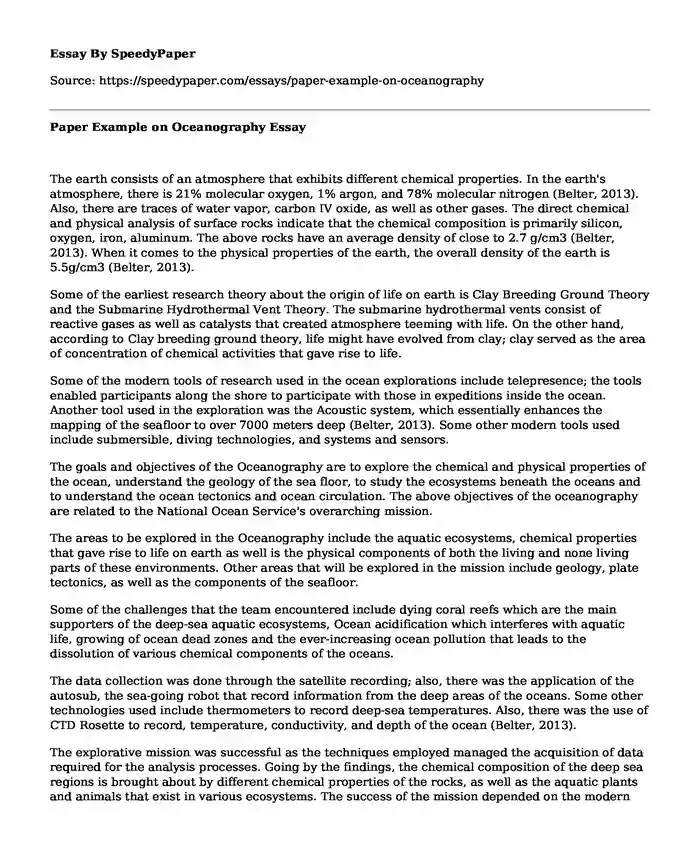The earth consists of an atmosphere that exhibits different chemical properties. In the earth's atmosphere, there is 21% molecular oxygen, 1% argon, and 78% molecular nitrogen (Belter, 2013). Also, there are traces of water vapor, carbon IV oxide, as well as other gases. The direct chemical and physical analysis of surface rocks indicate that the chemical composition is primarily silicon, oxygen, iron, aluminum. The above rocks have an average density of close to 2.7 g/cm3 (Belter, 2013). When it comes to the physical properties of the earth, the overall density of the earth is 5.5g/cm3 (Belter, 2013).
Some of the earliest research theory about the origin of life on earth is Clay Breeding Ground Theory and the Submarine Hydrothermal Vent Theory. The submarine hydrothermal vents consist of reactive gases as well as catalysts that created atmosphere teeming with life. On the other hand, according to Clay breeding ground theory, life might have evolved from clay; clay served as the area of concentration of chemical activities that gave rise to life.
Some of the modern tools of research used in the ocean explorations include telepresence; the tools enabled participants along the shore to participate with those in expeditions inside the ocean. Another tool used in the exploration was the Acoustic system, which essentially enhances the mapping of the seafloor to over 7000 meters deep (Belter, 2013). Some other modern tools used include submersible, diving technologies, and systems and sensors.
The goals and objectives of the Oceanography are to explore the chemical and physical properties of the ocean, understand the geology of the sea floor, to study the ecosystems beneath the oceans and to understand the ocean tectonics and ocean circulation. The above objectives of the oceanography are related to the National Ocean Service's overarching mission.
The areas to be explored in the Oceanography include the aquatic ecosystems, chemical properties that gave rise to life on earth as well is the physical components of both the living and none living parts of these environments. Other areas that will be explored in the mission include geology, plate tectonics, as well as the components of the seafloor.
Some of the challenges that the team encountered include dying coral reefs which are the main supporters of the deep-sea aquatic ecosystems, Ocean acidification which interferes with aquatic life, growing of ocean dead zones and the ever-increasing ocean pollution that leads to the dissolution of various chemical components of the oceans.
The data collection was done through the satellite recording; also, there was the application of the autosub, the sea-going robot that record information from the deep areas of the oceans. Some other technologies used include thermometers to record deep-sea temperatures. Also, there was the use of CTD Rosette to record, temperature, conductivity, and depth of the ocean (Belter, 2013).
The explorative mission was successful as the techniques employed managed the acquisition of data required for the analysis processes. Going by the findings, the chemical composition of the deep sea regions is brought about by different chemical properties of the rocks, as well as the aquatic plants and animals that exist in various ecosystems. The success of the mission depended on the modern technologies used as well as the techniques applied in the explorative processes (Belter, 2013).
The information gathered from the mission can be used to enhance studies or research processes in Oceanography. The new information obtained, the chemical components of the sea, the types of rocks as well as movements of tectonics can be applied in the general scientific study of the seas and oceans.
Reference
Belter, C. W., (2013). A bibliometric analysis of NOAA's Office of Ocean Exploration and Research. Scientometrics, 95(2), 629-644.
Cite this page
Paper Example on Oceanography. (2023, Jan 13). Retrieved from https://speedypaper.net/essays/paper-example-on-oceanography
Request Removal
If you are the original author of this essay and no longer wish to have it published on the SpeedyPaper website, please click below to request its removal:
- Business Analysis in a Free Essay Example
- Free Essay on Factors Affecting the Goals of Quality Education
- Daddy by Sylvia Plath - Essay Sample with Poem Analysis
- Free Essay Sample on Supplier Base Reduction
- Argumentative Essay Example: Marijuana Should Be legalized in the US
- Free Essay. Comparing Media Biases in Terms of Liberal-Progressive or Conservative Values
- Paper Exampl on How X-Rays Are Formed Within the X-Ray Tube
Popular categories





